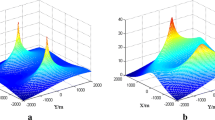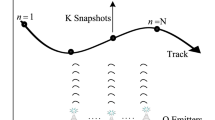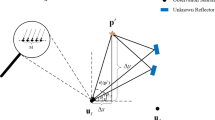Abstract
Compared with conventional two-step localization methods, direct position determination (DPD) is a promising technique that offers superior performance under low signal-to-noise ratio conditions. However, existing DPD methods mainly focus on complex circular sources without considering noncircular signals, which can be exploited to enhance the localization accuracy. This study proposes an improved subspace data fusion (SDF)-based DPD algorithm for multiple noncircular sources with a moving array. By constructing and decomposing the extended covariance matrices, extended noise subspaces are obtained for all positions of the moving array. The source positions are then directly estimated by fusing the extended noise subspaces without computing the intermediate parameters, thereby avoiding the data association problem inherent in two-step methods. Our proposed DPD algorithm combines the low complexity of SDF with the high robustness to noise and sensor errors that comes from exploiting signal noncircularity. Specifically, a closed-form expression for the localization mean square error (MSE) of the algorithm and the stochastic Cramér–Rao bound for strict-sense noncircular signals are derived. Simulation results validate our theoretical prediction for MSE and also demonstrate that the proposed algorithm outperforms other localization methods in terms of accuracy and capacity to resolve noncircular sources.









Similar content being viewed by others
References
H. Abeida, J.-P. Delmas, MUSIC-like estimation of direction of arrival for noncircular sources. IEEE Trans. Signal Process. 54(7), 2678–2690 (2006)
H. Abeida, J.-P. Delmas, Statistical performance of MUSIC-Like algorithms in resolving noncircular sources. IEEE Trans. Signal Process. 56(9), 4317–4329 (2008)
A. Amar, A.J. Weiss, Direct position determination of multiple radio signals. IEEE Int. Conf. Acoust. Speech Signal Process. 2, ii-81-4 (2004)
A. Amar, A.J. Weiss, A decoupled algorithm for geolocation of multiple emitters. Sig. Process. 87(10), 2348–2359 (2007)
D. Bruno, M. Oispuu, E. Ruthotto, Localization of multiple sources with a moving array using subspace data fusion, in Information Fusion, 2008 11th International Conference on. IEEE (2008), pp.1–7
P. Chargé, Y. Wang, J. Saillard, A non-circular sources direction finding method using polynomial rooting. Sig. Process. 81(8), 1765–1770 (2001)
J.-P. Delmas, H. Abeida, Stochastic Cramér–Rao bound for noncircular signals with application to DOA estimation. IEEE Trans. Signal Process. 52(11), 3192–3199 (2004)
Z.J. Fu, K. Ren, J.G. Shu, X.M. Sun, F.X. Huang, Enabling personalized search over encrypted outsourced data with efficiency improvement. IEEE Trans. Parallel Distrib. Syst. 27(9), 2546–2559 (2016)
J. Li, L. Yang, F. Guo, Coherent summation of multiple short-time signals for direct positioning of a wideband source based on delay and Doppler. Digit. Signal Proc. 48(C), 58–70 (2016)
S.C. Nardone, M.L. Graham, A closed-form solution to bearings-only target motion analysis. IEEE J. Ocean. Eng. 22(1), 168–178 (1997)
M. Oispuu, U. Nickel, Direct detection and position determination of multiple sources with intermittent emission. Sig. Process. 90(12), 3056–3064 (2010)
I. P. Pokrajac, D. Vučić, One-step signal selective direct positioning algorithm of cyclostationary signals, in 2010 5th European Conference on Circuits and Systems for Communications (ECCSC) (2010), pp. 298–301
A.M. Reuven, A.J. Weiss, Direct position determination of cyclostationary signals. Sig. Process. 89(12), 2448–2464 (2009)
J.Y. Shen, A.F. Molisch, J. Salmi, Accurate passive location estimation using TOA measurements. IEEE Trans. Wireless Commun. 11(6), 253–257 (2011)
P. Stoica, A. Nehorai, T. Söderström, Decentralized array processing using the MODE algorithm. Circuits Syst. Signal Process. 14(1), 17–38 (1995)
T. Tirer, A.J. Weiss, High resolution direct position determination of radio frequency sources. IEEE Signal Process. Lett. 23(2), 192–196 (2016)
L. Tzafri, A.J. Weiss, High-resolution direct position determination using MVDR. IEEE Trans. Wireless Commun. 15(9), 6449–6461 (2016)
D. Wang, Y. Wu, Statistical performance analysis of direct position determination method based on Doppler shifts in presence of model errors. Multidimens. Syst. Signal Process. 1–34 (2015)
D. Wang, G. Zhang, C.Y. Shen, J. Zhang, Direct position determination algorithm for constant modulus signals with single moving observer. Acta Aeronaut. Astronaut. Sin. 37(5), 1622–1633 (2016)
M. Wax, T. Kailath, Optimum localization of multiple sources by passive arrays. IEEE Trans. Acoust. Speech Signal Process. 31(5), 1210–1217 (1983)
A.J. Weiss, Direct position determination of narrowband radio frequency transmitters. IEEE Signal Process. Lett. 11(5), 513–516 (2004)
A.J. Weiss, A. Amar, Direct position determination of multiple radio signals. EURASIP J. Appl. Signal Process. 1, 37–49 (2005)
F. Wen, Q. Wan, L.Y. Luo, Time-difference-of-arrival estimation for noncircular signals using information theory. AEU Int. J. Electron. Commun. 67(67), 242–245 (2013)
Y. Xia, C.C. Took, D.P. Mandic, An augmented affine projection algorithm for the filtering of noncircular complex signals. Sig. Process. 90(6), 1788–1799 (2010)
J.X. Yin, Y. Wu, D. Wang, An auto-calibration method for spatially and temporally correlated noncircular sources in unknown noise fields. Multidimens. Syst. Signal Process. 27(2), 511–539 (2016)
H. Zhang, L. Li, W. Li, Independent vector analysis for convolutive blind noncircular source separation, in IEEE 2010 International Symposium on Intelligent Signal Processing and Communication Systems (ISPACS) (2010), pp. 1–4
X.D. Zhang, Matrix Analysis and Application (Tsinghua University Press, Beijing, 2004)
Y.H. Zhang, X.M. Sun, B.W. Wang, Efficient algorithm for K-barrier coverage based on integer linear programming. China Commun. 13(7), 16–23 (2016)
J.F. Zhang, T.S. Qiu, A novel covariance based noncircular sources direction finding method under impulsive noise environment. Sig. Process. 98(8), 252–262 (2014)
Acknowledgements
The authors would like to thank the Editor-in-Chief, Prof. M. N. S. Swamy, and the Associate Editor for their helpful suggestions in revising and improving our paper. This work was supported by the National Natural Science Foundation of China under Grant 61201381, China Postdoctoral Science Foundation under Grant 2016M592989, the Outstanding Youth Foundation of Information Engineering University under Grant 2016603201, and the Self-Topic Foundation of Information Engineering University under Grant 2016600701.
Author information
Authors and Affiliations
Corresponding author
Appendices
Appendix 1
Proof of (29):
Let \(p_i\) be the ith entry of the position vector \({\varvec{p}}\in {\mathbb {R}}^{D\times 1}\). To derive \({\hat{{\varvec{v}}}}^{1( {\varvec{p}} )} (\varvec{\bar{{p}}}_q )\), we need to start from the first-order partial derivative of \(\hat{{V}}({\varvec{p}})\) (see 20) with respect to \(p_i\). This is given by
where the fact that \(\hat{{g}}_{k1} ({\varvec{p}})\) has a real value for its Hermitian form is used. \(\hat{{g}}_{k1}^{( {p_i } )} ({\varvec{p}})\) and \(\hat{{g}}_{k2}^{( {p_i } )} ({\varvec{p}})\) are the first-order partial derivatives of \(\hat{{g}}_{k1} ({\varvec{p}})\) and \(\hat{{g}}_{k2} ({\varvec{p}})\) with respect to \(p_i\) and can be written as
in which \({\varvec{a}}_k^{( {p_i } )} ({\varvec{p}})\) denotes the first-order partial derivative of \({\varvec{a}}_k ({\varvec{p}})\) with respect to \(p_i\). Inserting (49) into (48) and replacing \({\varvec{p}}\) with the true position \(\varvec{\bar{{p}}}_q\) leads to
After substituting \({\hat{\varvec{{\varPi }}}}_{k1} =\varvec{{\varPi }}_{k1} +\varvec{\delta \hat{{{\varPi }}}}_{k1} +o( {\Vert {\varvec{\delta \hat{{{\varPi }}}}_{k1} } \Vert _{\mathrm{F}} })\) and \({\hat{\varvec{{\varPi }}}}_{k2} =\varvec{{\varPi }}_{k2} +\varvec{\delta \hat{{{\varPi }}}}_{k2} +o( {\Vert {\varvec{\delta \hat{{{\varPi }}}}_{k2} } \Vert _{\mathrm{F}}})\) into (50), we have
Now, we recall the ith component of the matrix equation in (26):
By comparing the terms in (51) with those in (52), we obtain an expression for \(\hat{{v}}^{1( {p_i } )} (\varvec{\bar{{p}}}_q)\) as
Using \(\hbox {vec}[{\varvec{XYZ}}]=( {{\varvec{Z}}^{\mathrm{T}}\otimes {\varvec{X}}} )\hbox {vec}[{\varvec{Y}}]\) (see [27]), (53) becomes
As \(\hat{{v}}^{1( {p_i } )} (\varvec{\bar{{p}}}_q )\) is the ith element of \({\hat{{\varvec{v}}}}^{1( {\varvec{p}} )} (\varvec{\bar{{p}}}_q )\), the expression for \({\hat{{\varvec{v}}}}^{1( {\varvec{p}} )} (\varvec{\bar{{p}}}_q )\) in (29) is given by (54).
Appendix 2
Proof of (31):
For the expression \({\varvec{H}}_q =\mathop {\hbox {lim}}\limits _{L\rightarrow \infty } {\hat{{\varvec{V}}}}^{( {\varvec{p,p}} )} (\varvec{\bar{{p}}}_q )\), we first derive the i, jth entry. Based on (48), the second-order partial derivative of \(\hat{{V}}({\varvec{p}})\) can be further calculated as
where \(\hat{{g}}_{k1}^{( {p_i } )} ({\varvec{p}})\), \(\hat{{g}}_{k1}^{( {p_j } )} ({\varvec{p}})\), \(\hat{{g}}_{k2}^{( {p_i } )} ({\varvec{p}})\), and \(\hat{{g}}_{k2}^{( {p_j } )} ({\varvec{p}})\) have similar expressions as those in (49). \(\hat{{g}}_{k1}^{( {p_i ,p_j } )} ({\varvec{p}})\) and \(\hat{{g}}_{k2}^{( {p_i ,p_j } )} ({\varvec{p}})\) represent the second-order partial derivatives of \(\hat{{g}}_{k1} ({\varvec{p}})\) and \(\hat{{g}}_{k2} ({\varvec{p}})\), respectively, and can be expressed as
Here, \({\varvec{a}}_k^{( {p_i ,p_j } )} ({\varvec{p}})=\frac{\partial ^{2}{\varvec{a}}_k ({\varvec{p}})}{\partial p_i \partial p_j }\) denotes the second-order partial derivative of \({\varvec{a}}_k ({\varvec{p}})\).
According to (10), we have \(\varvec{{\varPi }}_{k1} {\varvec{a}}_k (\varvec{\bar{{p}}}_q )+\varvec{{\varPi }}_{k2} {\varvec{a}}_k^*(\varvec{\bar{{p}}}_q) e^{-\hbox {j}\bar{{{\phi }}}_q }={\varvec{0}}\) (\(\bar{{{\phi }}}_q\) is the true value of \({\phi }_q\)), following which it can be proved that \(\varvec{{\varPi }}_{k1} {\varvec{a}}_k (\varvec{\bar{{p}}}_q ){\varvec{a}}_k^{\mathrm{H}}(\varvec{\bar{{p}}}_q )\varvec{{\varPi }}_{k1} =\varvec{{\varPi }}_{k2} {\varvec{a}}_k^*(\varvec{\bar{{p}}}_q ){\varvec{a}}_k^{\mathrm{T}}(\varvec{\bar{{p}}}_q )\varvec{{\varPi }}_{k2}^*\) (see [1]). Then, using this result and substituting (56) into (55) with \({\varvec{p}}=\varvec{\bar{{p}}}_q\), we obtain
For simplicity, we let \({\varvec{W}}_{k1} (\varvec{\bar{{p}}}_q )={\varvec{a}}_k^{\mathrm{H}}(\varvec{\bar{{p}}}_q )\varvec{{\varPi }}_{k1} {\varvec{a}}_k (\varvec{\bar{{p}}}_q )\varvec{{\varPi }}_{k1} -\varvec{{\varPi }}_{k2} {\varvec{a}}_k^{*}(\varvec{\bar{{p}}}_q ){\varvec{a}}_k^{\mathrm{T}}(\varvec{\bar{{p}}}_q )\varvec{{\varPi }}_{k2}^*\) and \({\varvec{W}}_{k2} (\varvec{\bar{{p}}}_q )={\varvec{a}}_k^{\mathrm{T}}(\varvec{\bar{{p}}}_q )\varvec{{\varPi }}_{k2}^*{\varvec{a}}_k (\varvec{\bar{{p}}}_q )\varvec{{\varPi }}_{k2} -\varvec{{\varPi }}_{k1} {\varvec{a}}_k (\varvec{\bar{{p}}}_q ){\varvec{a}}_k^{\mathrm{T}}(\varvec{\bar{{p}}}_q )\varvec{{\varPi }}_{k1}^*\). Consequently, the expression in (57) reduces to
Finally, the expression for \({\varvec{H}}_q\) in (31) can be deduced from (58) by noting that \({\varvec{a}}_k^{( {p_i } )} (\varvec{\bar{{p}}}_q )\) and \({\varvec{a}}_k^{( {p_j } )} (\varvec{\bar{{p}}}_q )\) are the ith andjth columns of \({\varvec{A}}_k^{( {\varvec{p}} )} (\varvec{\bar{{p}}}_q )\) for \(k=1,2,\ldots ,K\).
Appendix 3
Proof of (34):
Inserting \(\Delta {\varvec{p}}_q =-{\varvec{H}}_q^{-1}{\hat{{\varvec{v}}}}^{1( {\varvec{p}} )} (\varvec{\bar{{p}}}_q )\) into \({\varvec{C}}_{{\varvec{p}}_q } =\hbox {E}[{\Delta {\varvec{p}}_q \Delta {\varvec{p}}_q^{\mathrm{T}}}]\) yields
Recall that the batches of data in K time slots are assumed to be statistically independent. Therefore, the perturbation vectors for K time slots are uncorrelated, leading to
Based on (60), using \(\hbox {Re}\{ {\varvec{x}} \} \hbox {Re}\{ {{\varvec{x}}^{\mathrm{T}}} \} = \frac{1}{2} \hbox {Re}\{ {\varvec{xx}^{\mathrm{T}}+\varvec{xx}^{\mathrm{H}}} \}\) and the expression for \({\hat{{\varvec{v}}}}^{1( {\varvec{p}} )} (\varvec{\bar{{p}}}_q )\) given in (29), we can write the covariance of \({\hat{{\varvec{v}}}}^{1( {\varvec{p}} )} (\varvec{\bar{{p}}}_q )\) as
where \(\varvec{\delta \hat{{\pi }}}=[{\hbox {vec}[{\varvec{\delta \hat{{{\varPi }}}}_{k1} }]^{\mathrm{T}}\hbox {,vec}[{\varvec{\delta \hat{{{\varPi }}}}_{k2} }]^{\mathrm{T}}\hbox {,vec}[{\varvec{\delta \hat{{{\varPi }}}}_{k2}^*}]^{\mathrm{T}}} ]^{\mathrm{T}}\). \({\varvec{C}}_{\varvec{{\varPi }}_{k1} ,\varvec{{\varPi }}_{k2} ,\varvec{{\varPi }}_{k2}^*}\) and \(\varvec{{C}}_{\varvec{{\varPi }}_{k1} ,\varvec{{\varPi }}_{k2} ,\varvec{{\varPi }}_{k2}^*}^{\prime }\) are the covariance matrix and unconjugated covariance matrix of \(\sqrt{L}\varvec{\delta \hat{{\pi }}}\), respectively. Then, because \(\hbox {Re}\{ {\varvec{X}} \}=\frac{1}{2}( {{\varvec{X}}+{\varvec{X}}^{*}})\), (61) becomes
where \(\varvec{{C}}_{\tilde{\varvec{{\varPi }}}_k}^{\prime }\) are defined in (33). After substituting (62) into (59), the proof of (34) is complete.
Appendix 4
Derivation of \(\frac{\partial \tilde{{\varvec{y}}}}{\partial \tilde{{\varvec{p}}}^{\mathrm{T}}}\) and \(\frac{\partial \tilde{{\varvec{y}}}}{\partial \varvec{\eta }^{\mathrm{T}}}\):
To further derive the expressions for \(\frac{\partial \tilde{{\varvec{y}}}}{\partial \tilde{{\varvec{p}}}^{\mathrm{T}}}\) and \(\frac{\partial \tilde{{\varvec{y}}}}{\partial \varvec{\eta }^{\mathrm{T}}}\) in (45), we first attempt to compute \(\frac{\partial \varvec{{{\tilde{y}}}}_k^{\prime }}{\partial \tilde{{\varvec{p}}}^{\mathrm{T}}}\), \(\frac{\partial \varvec{{{\tilde{y}}}}_k^{\prime }}{\partial {\varvec{{\phi }}}^{\mathrm{T}}}\), \(\frac{\partial \varvec{{{\tilde{y}}}}_k^{\prime }}{\partial \varvec{\omega }^{\mathrm{T}}}\), and \(\frac{\partial \varvec{{{\tilde{y}}}}_k^{\prime }}{\partial \sigma _{\mathrm{n}}^2}\) for
Applying the formula \(\hbox {vec}[{\varvec{XYZ}}]= ({{\varvec{Z}}^{\mathrm{T}}\otimes {\varvec{X}}}) \hbox {vec}[{\varvec{Y}}]\) (see [27]) to \(\tilde{{\varvec{y}}}_k =\hbox {vec}[{\tilde{{\varvec{R}}}_k }]\) yields
where \({\varvec{r}}_k^{\mathrm{s}} =\hbox {vec} [{{\varvec{R}}_k^{\mathrm{s}} }]\).
Let \(p_{qi} ( {i=1,2,\ldots ,D} )\) be the ith element of the position vector \({\varvec{p}}_q ( q=1,2,\ldots ,Q)\). Then, we define the vector \(\tilde{{\varvec{p}}}_i =[p_{1i} ,p_{2i} , \ldots ,p_{Qi} ]^{\mathrm{T}}\) and the following two derivative matrices:
for \(k=1,2,\ldots ,K\). As the sources are assumed to be uncorrelated, \({\varvec{R}}_k^{\mathrm{s}}\) is a diagonal matrix. Using this result, a series of manipulations based on (64) lead to
for \(k=1,2,\ldots ,K\). (Here, \({\varvec{A}}_{\mathrm{NC},k}\) denotes \({\varvec{A}}_{\mathrm{NC},k} (\tilde{{\varvec{p}}}, {\varvec{{\phi }}})\).) Combining (66) and \(\varvec{{{\tilde{y}}}}_k^{\prime } =( {\tilde{{\varvec{R}}}_k^{-\mathrm{T}/2}\otimes \tilde{{\varvec{R}}}_k^{-1/2}} )\tilde{{\varvec{y}}}_k\), we employ the formulas \(( {{\varvec{B}}\otimes {\varvec{C}}}) ({{\varvec{X}}*{\varvec{Y}}}) = \varvec{BX}*\varvec{CY}\) and \(\hbox {vec}[{\varvec{XYZ}}] = ({{\varvec{Z}}^{\mathrm{T}}\otimes {\varvec{X}}} )\hbox {vec}[{\varvec{Y}}]\) (see [27]) to obtain the partial derivatives of \(\varvec{{{\tilde{y}}}}_k^{\prime }\):
Now, \(\frac{\partial \tilde{{\varvec{y}}}}{\partial \tilde{{\varvec{p}}}^{\mathrm{T}}}\) and \(\frac{\partial \tilde{{\varvec{y}}}}{\partial \varvec{\eta }^{\mathrm{T}}}\) can be constituted by inserting the above expressions into (63).
Rights and permissions
About this article
Cite this article
Yin, Jx., Wu, Y. & Wang, D. Direct Position Determination of Multiple Noncircular Sources with a Moving Array. Circuits Syst Signal Process 36, 4050–4076 (2017). https://doi.org/10.1007/s00034-017-0499-4
Received:
Revised:
Accepted:
Published:
Issue Date:
DOI: https://doi.org/10.1007/s00034-017-0499-4




